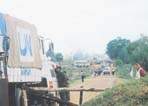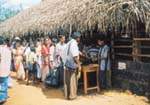| Plus |
|
|||||
|
On
the A9 For some, this route finally provides an affordable opportunity to visit relatives living in the North, for others it opens a path to assess for themselves the devastation that almost two decades of war has left behind.
Having been to Jaffna during the late 1970s and '80s, she was eager to revisit the peninsula. "Although we have demarcated and seemingly separated our lands, it is still one Sri Lanka. And it was in that spirit that we chose to go." "The first thing one encounters of course, are the checkpoints. Initially we visited the LTTE head office checkpoint at Vavuniya because there was talk of the need to get their prior permission to travel north but they were very cordial to us and said there was no permission needed. We even gave them some sweetmeats we had brought with us. The Army was equally warm. Of course, the fact that we had a former MP Vasudeva Nanayakkara travelling with us may have contributed to this, for we did see huge throngs of people being compelled to queue up at the checkpoint in Omanthai," she said. Ms. Fernando explains that after the Army checkpoint in Omanthai, one encounters two ICRC camps situated within a few yards of each other, one on the side of the Army camp and the other next to that of the LTTE. Travellers are required to unload all their baggage and walk these few yards between the two ICRC camps. If you are travelling in a private vehicle, it is then checked and permitted to pass but if you travel by bus, from that point you are transported to Muhamalai by the LTTE. "So you could see poor people pushing barrels and elderly women laden with bags and suitcases making their way between the two ICRC camps. And from Muhamalai, people travelling by road, board government buses which ply to Jaffna." The road runs along mostly jungle. Long stretches have yellow tape indicating landmine infested areas. "If you have travelled this route earlier you find that the contrast today is striking. There is devastation everywhere. In Kilinochchi except for a few buildings, everything else has collapsed. The Kilinochchi Central School is literally roofless but you still find children having their lessons among the rubble. Right along you find that nothing has been spared because every house along the road is bullet riddled and damaged." "It was to me a devastating experience to realize we have allowed our own country to be destroyed like this. And it is apparent that the LTTE alone has not inflicted all the damage because the Army too has obviously made their contribution," she said. Also clearly noticed as they travelled from Kilinochchi to Chavakachcheri town, was that most of the tall palmyrah and coconut trees lining the roads are just stumps, bare of any branches due to heavy shelling in the area. Off Kilinochchi the group visited an orphanage housing over 600 children between 6-17 months. "It was to this orphanage that the rebels brought little children who were found among the rubble etc. after crossfire or bombing. Having been a teacher myself, I immediately noticed that these children were quite unlike a group of average toddlers. When told they had visitors, they quietly lined up in a manner that obviously indicated that although they were physically unharmed, their experiences had left severe psychological scars," she explained. "When we were young we interacted with our Tamil friends in school and university but the war has today stifled any opportunity for this sort of interaction. If we are to bridge the gap between the Sinhalese and Tamils, we must encourage interaction among our children," she said. Along the main road from Chavakachcheri to Jafnna town, said Ms. Fernando, there were no homes to be seen, only broken chairs, tables and dilapidated government buildings swamped by overgrown shrubs and bushes. "You encounter a heavy Army presence in Jaffna town. The town itself is bustling but if you were to take a walk, everyone you meet has a story to tell. There are unannounced six-hour power cuts and uninterrupted electricity is only assured between 10.30 p.m. to 6.30 a.m. But people have got used to these things, which seem so irksome to us living in Colombo. They know there is nothing they can do about it." They also met with the Mothers' Front in Jaffna, who said that the government has now accepted that over 150 out of 400 'disappeared' persons cannot be located. These mothers insist that they do not want the compensation. They just want to find out what happened to their boys. And because of the disappearances which are now commonplace, Jaffna town is virtually deserted after 7 p.m. But the silver lining is that agriculture seems to be flourishing in the peninsula with many farmers returning to their fields to resume cultivation. "There are a few makeshift tea stalls put up near the Pulliankulam LTTE checkpoint where we saw farmers sipping toddy and having a smoke. This was one distinct feature that indicated that things can indeed get back to the way they used to be," Ms. Fernando said. |
||||||
Copyright © 2001 Wijeya Newspapers
Ltd. All rights reserved. |

 Attorney-at-Law
Nimalka Fernando made the trip to Jaffna along the A9 route last
month. "As a peace activist, I welcomed the MOU between the
government and the LTTE and promised the Women's Development Centre
in Jaffna that I would spend the Sinhala and Tamil New Year with
them, if the A9 was re-opened," she said.
Attorney-at-Law
Nimalka Fernando made the trip to Jaffna along the A9 route last
month. "As a peace activist, I welcomed the MOU between the
government and the LTTE and promised the Women's Development Centre
in Jaffna that I would spend the Sinhala and Tamil New Year with
them, if the A9 was re-opened," she said.